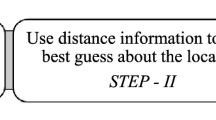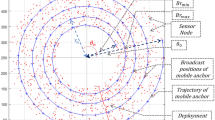Abstract
Achieving high accuracy with minimum reference nodes, anchor nodes, and computation and communication costs is a goal for the localization in wireless sensor networks. Targeting at this goal, a localization scheme called concentric distributed localization with the tripodal anchor structure and grid scan (CDL-TAGS) requiring two reference nodes and a few anchor nodes is proposed in this paper. Under the precondition that the system has randomly distributed normal sensor nodes, a tripodal anchor structure is first designed. With this structure, the localization process is started from the centroid node and then stretched outward to the farthest normal nodes. Based on the two best reference nodes, a virtual point is generated to serve as the third reference node. In the CDL-TAGS scheme, a grid scan algorithm is employed to estimate the position of a normal node. Finally, we show that the communication overhead and time and space complexities among sensor nodes for CDL-TAGS can be kept at a low level. In addition, CDL-TAGS can achieve better accuracy with minimum anchor nodes as compared to some closely related localization schemes in the literature through simulation results.
Similar content being viewed by others
References
Albowicz, J., Chen, A., & Zhang, L. (2001). Recursive position estimation in sensor networks. In Proceedings of IEEE international conference on network protocols (ICNP’01), November 2001, pp. 35–41.
Aspnes J., Eren T., Goldenberg D. K., Morse A. S., Whiteley W., Yang Y. R., Anderson B. D. O., Belhumeur P. N. (2006) A theory of network localization. IEEE Transactions on Mobile Computing 5(12): 1663–1678
Blumenthal, J., Grossmann, R., Golatowski, F., & Timmermann, D. (2007). Weighted centroid localization in zigbee-based sensor networks. In Proceedings of IEEE workshop on internet server performance (WISP’07), October 2007, pp. 1–6.
Boukerche A., Oliveira H. A. B. F., Nakamura E. F., Loureiro A. A. F. (2007) Localization systems for wireless sensor networks. IEEE Wireless Communications 14(6): 6–12
Bulusu N., Heidemann J., Estrin D. (2000) GPS-less low-cost outdoor localization for very small devices. IEEE Personal Communications 7(5): 28–34
Capkun, S., Hamdi, M., & Hubaux, J. P. (2001). GPS-free positioning in mobile ad-hoc networks. In Proceedings of IEEE system sciences’01, January 2001, pp. 1–10.
Chaczko, Z., Klempous, R., Nikodem, J., & Nikodem, M. (2007). Methods of sensors localization in wireless sensor networks. In Proceedings of IEEE international conference and workshops on the engineering of computer-based systems (ECBS’07), March 2007, pp. 145–152.
Forghani, Y. (2008). A new approximate positioning approach in wireless sensor networks. In Proceedings of IEEE INCC’08, May 2008, pp. 138–143.
Forghani, Y. (2008). A new weighted centroid localization algorithm in wireless sensor networks. In Proceedings of IEEE international conference on computer and information technology (ICCIT’08), December 2008, pp. 89–93.
Girod, L., & Estrin, D. (2001). Robust range estimation using acoustic and multimodal sensing. In Proceedings of IEEE international conference on intelligent robots and systems (IROS’01), November 2001, pp. 1312–1320.
He, T., Huang, C. D., Blum, B. M., Stankovic, J. A., & Abdelzaher, T. (2003). Range-free localization schemes in large scale sensor networks. In Proceedings of ACM international conference on mobile computing and networking (MobiCom’03), pp. 81–95.
Karp, B., & Kung, H. T. (2000). GPSR: Greedy perimeter stateless routing for wireless networks. In Proceedings of ACM international conference on mobile computing and networking (MobiCom’00), Auguat 2000, pp. 243–254.
Liao W. H., Shih K. P., Lee Y. C. (2008) A localization protocol with adaptive power control in wireless sensor networks. Computer Communications 31(10): 2496–2504
Mannasim, http://www.mannasim.dcc.ufmg.br/.
Niculescu D. & Nath B. (2003). Ad hoc positioning system (APS) using AOA. In Proceedings of IEEE international conference on computer communications (INFOCOM’03), April 2003, pp. 1734–1743.
Priyantha, N. B., Chakraborty, A., & Balakrishnan, H. (2000). The cricket location-support system. In Proceedings of ACM international conference on mobile computing and networking (MobiCom’00), August 2000, pp. 32–43.
Reichenbach, F., Born, A., Timmermann, D., & Bill, R. (2006). A distributed linear least squares method for precise localization with low complexity in wireless sensor network. In Proceedings of distributed computing sensor systems’06, pp. 514–528.
Sau, B., & Mukhopadhyaya, K. (2009). Length-based anchor-free localization in a fully covered sensor network. In Proceedings of IEEE international conference on communication systems and networks (COMSNETS’09), January 2009, pp. 1–10.
Savvides, A., Han, C. C., Srivastava, M. B. (2001). Dynamic fine-grained localization in ad-hoc wireless sensor networks. In Proceedings of ACM international conference on mobile computing and networking (MobiCom’01), July 2001.
Sheu J. P., Chen P. C., Hsu C. S. (2008) A distributed localization scheme for wireless sensor networks with improved grid-scan and vector-based refinement. IEEE Transactions on Mobile Computing 7(9): 1110–1123
The network simulator ns–2, http://www.isi.edu/nsnam/ns/ns-documentation.html.
Tian, H., Wang, S., & Xie, X. H. (2007). Localization using cooperative AOA approach. In Proceedings of IEEE international conference on wireless communications, networking and mobile computing (WICOM’07), September 2007, pp. 2416–2419.
Vivekanandan V., Wong V. W. S. (2007) Concentric anchor beacon localization algorithm for wireless sensor networks. IEEE Transactions on Vehicular Technology 56(5): 2733–2744
Wang, J. Z., & Jin, H. (2009). Improvement on APIT localization algorithms for wireless sensor networks. In Proceedings of IEEE international conference on networks security, wireless communications and trusted computing (NSWCTC’09), April 2009, pp. 719–723.
Xu, C., Cao, L., Sun, Q., & Zhou, H. (2008). Farthest 2 anchors in radio range localization in wireless sensor networks. In Proceedings of IEEE international conference on wireless communications, networking and mobile computing (WICOM’08), October 2008, pp. 1–3.
Yan, Z., Chang, Y., Shen, Z., & Zhang, Y. (2009). A grid-scan localization algorithm for wireless sensor network. In Proceedings of IEEE international conference on communications and mobile computing (CMC’09), January 2009, pp. 142–146.
Yu, B., & Sycara, K. (2006). Geographic routing in distributed sensor systems without location information. In Proceedings of IEEE international conference on information fusion (ICIF’06), July 2006, pp. 1–8.
Author information
Authors and Affiliations
Corresponding author
Rights and permissions
About this article
Cite this article
Ferng, HW., Arwani, I. Concentric Distributed Localization Based on the Tripodal Anchor Structure and Grid Scan for Wireless Sensor Networks. Wireless Pers Commun 68, 1707–1729 (2013). https://doi.org/10.1007/s11277-012-0546-1
Published:
Issue Date:
DOI: https://doi.org/10.1007/s11277-012-0546-1




